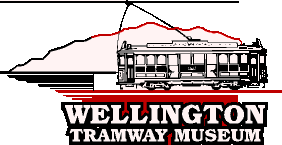History of Trams in Wellington
Steam Trams
Wellington
entered the tramway story on the 24th August 1878 when the first city
steam tram service in the southern hemisphere was opened by the Governor
of the Colony, the Marquis of Normanby.
 The Wellington City Tramways Company’s route was laid from a terminal
near the Government Buildings in Lambton Quay to the depot at the corner
of Adelaide Road and King Street.
The Wellington City Tramways Company’s route was laid from a terminal
near the Government Buildings in Lambton Quay to the depot at the corner
of Adelaide Road and King Street.
Three small steam engines, ‘Hibernia’, ‘Wellington’ and ‘Zealandia’, each hauled a passenger tramcar along with two horse drawn cars operated during the opening day.
They were part of a fleet of eight steam motors named: Florence, Hibernia, Wellington, Zealandia, Victoria, Cambria, Scotia and Anglia. They were supplied by Merryweather and Sons Ltd in England and fourteen passenger cars and four goods wagons were supplied by John Stevenson and Company of New York.
The track was two miles and 62 chains (4.47 Km) in length and laid to a gauge of three foot six inches (1067 mm).
Horse Trams
The noise, soot and disturbance to horses created a lot of opposition to the steam engines and they were replaced with horses by January 1882.
 The company was experiencing financial
difficulties around this time and this undoubtably influenced the decision
to dispense with the steam engines.
The company was experiencing financial
difficulties around this time and this undoubtably influenced the decision
to dispense with the steam engines.
The financial state of the company remained in a perilous condition and after a number of management changes, was purchased for a minimal price by the Wellington City Corporation in 1900.
The following year saw the corporation decide to adopt electric trams for the city and in 1902, a contract was entered into with McCartney, McElroy and Company Limited of London to instal a new and extended system.
Electric Trams
On the 30th June 1904, the first electric tram ran from the new depot at Newtown to the northern side of the Basin Reserve and so signalled the end of the horse drawn service two months later.
 By this time, the
electric service had been extended through the city to the new Lambton
Railway station that had been moved further along Thorndon Quay towards
the city.
By this time, the
electric service had been extended through the city to the new Lambton
Railway station that had been moved further along Thorndon Quay towards
the city.
With the change to electric operation, the gauge of the track was increased to four feet (1219 mm) and the total length of the route was increased to ten miles (sixteen kilometres).
There were thirty three tramcars with about half being single deckers and the remainder doubled decked, all imported from England.
Each tram service displayed a destination sign and route number, which did not necissarily correspond with a particular destination. The route numbers during the last few years of operation were:
- Lambton Quay to Courtenay Place to Island Bay
- Lambton Quay to Courtenay Place to Haitaitai and to Kilbirnie, Lyall Bay, Seatoun or Miramar via Haitaitai
- Lambton Quay to Courtenay Place to Kilbirnie, Lyall Bay or Seatoun via Newtown and Constable Street
- Thorndon Quay to city to Cuba and Vivian Streets to Newtown
- Customhouse Quay, Jervois Quay to Manners Street and Courtenay Place
- Wadestown to city and Cuba and Wallace Streets (used after closure of Wadestown route for trams routed via Jervois Quay Cuba Street
- From the Railway Station or the city to Aro Street or Brooklyn
- Railway Station to Lambton Quay via Stout Street
- City to Oriental Bay (later used by trams to Courtney Place via Customhouse Quay and Willis Street
- Used by trams routed via Wakefield Street
- Lambton Quay to Newtown via Cuba and Wallace Streets
The end of the Tramway in Wellington
On the second of May 1964,
large crowds gathered along the remaining route to witness the last trams
to run through the streets of Wellington and also the last trams in regular
passenger service in any city in New Zealand.
Three trams had been decorated especially for the occasion, numbers 250,
251 and 252. The trams had been driven down to a closing ceremony at Thorndon
for the tram sheds there then after speeches from invited dignatories,
they moved off for the final time bound for Newtown.
Crowds lined the streets all along the route and the trams moved slowly
in procession with a local brass band. Upon reaching the Newtown Sheds,
another ceremony was held with the symbolic closing of the large shed
doors for the final time.
In their heyday Wellington Tramways covered over 52 kilometres of tram route (map), all constructed to the unusual track gauge of 4 feet. Suburbs served by the trams, with opening and closing dates, were:
| Opened | Line | Closed |
| 1904 1905 1904 1906 1904 1907 1907 1907 1911 1915 1911 1907-11 1904 1929 |
Newtown/Thorndon Island Bay Oriental Bay Brooklyn Aro Street Hataitai Hataitai/Kilbirnie/Miramar Seatoun Lyall Bay Crawford Road (Route 3) Wadestown Karori Tinakori Road Northland |
1964 1963 1950 1957 1957 1962 1957 1958 1960 1961 1949 1954 1949 1954 |
Today the Kelburn Cable Car (1 metre track gauge) remains, with its modern
cars.













